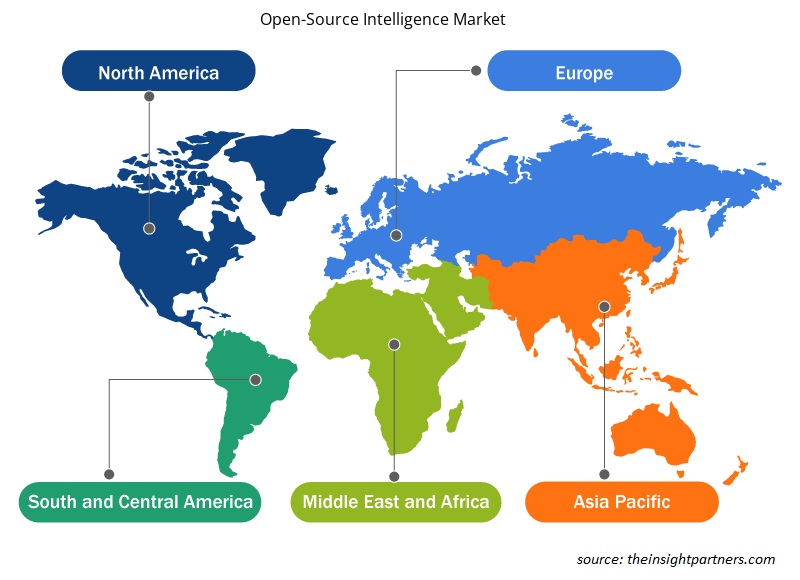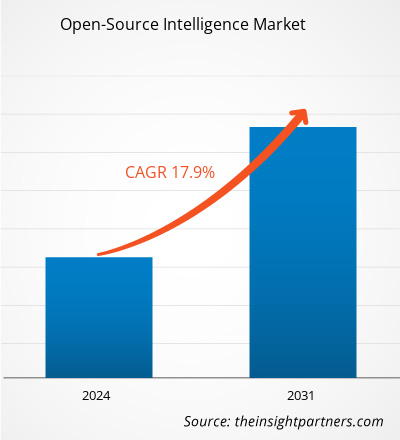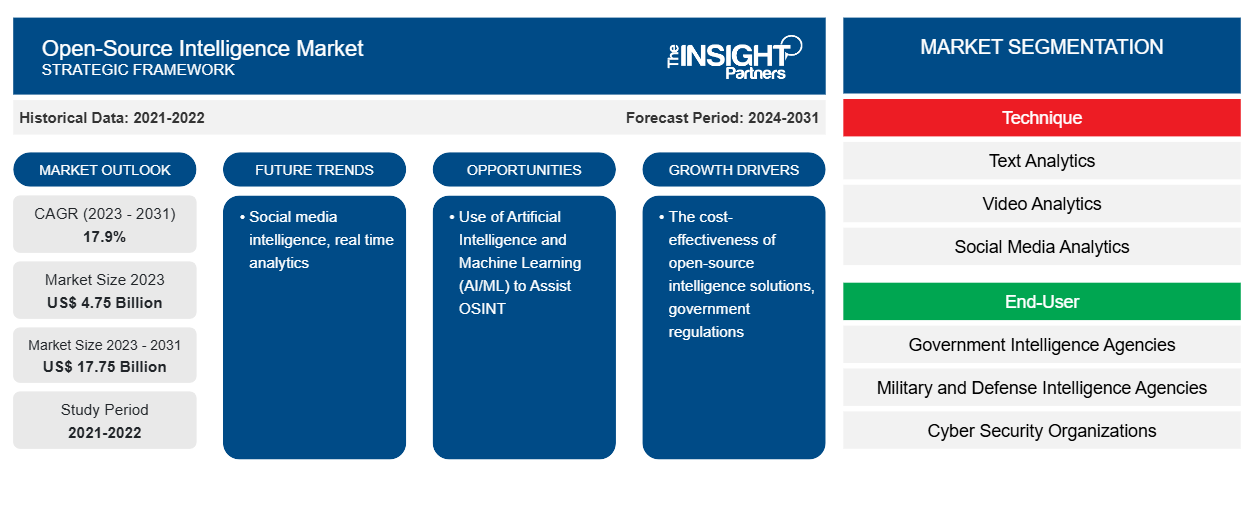Se prevé que el tamaño del mercado de inteligencia de fuentes abiertas alcance los 17.750 millones de dólares en 2031, frente a los 4.750 millones de dólares en 2023. Se espera que el mercado registre una CAGR del 17,9 % durante el período 2023-2031. Es probable que la inteligencia de redes sociales y el análisis en tiempo real sigan siendo una tendencia clave en el mercado.CAGR of 17.9% during 2023–2031. Social media intelligence and real-time analytics are likely to remain a key trend in the market.
Análisis del mercado de inteligencia de fuentes abiertas
La inteligencia derivada de la recopilación, evaluación y análisis de datos de acceso público para responder a una consulta de inteligencia en particular se conoce como inteligencia de fuentes abiertas (OSINT). Como herramienta de ciberseguridad, las empresas utilizan ampliamente OSINT para evaluar amenazas de seguridad y encontrar vulnerabilidades en su infraestructura de TI. Los piratas informáticos y los ciberdelincuentes también emplean técnicas OSINT para el phishing, la ingeniería social y la revelación de posibles objetivos de ciberataques. Más allá de la ciberseguridad, la inteligencia de fuentes abiertas también se puede utilizar en campos como la aplicación de la ley, el marketing, la seguridad nacional, los medios de comunicación y los estudios académicos.
Panorama del mercado de inteligencia de fuentes abiertas
En los últimos años, las campañas de desinformación y desinformación han atraído más la atención como un peligro para la seguridad nacional y la sociedad en general. En los últimos años, estos riesgos han cambiado como resultado de la inestabilidad política persistente que ha permitido la difusión de información engañosa. Como resultado, el ecosistema en torno a la desinformación y la contradesinformación se ha vuelto más profesional, lo que ha impulsado la demanda del mercado de inteligencia de código abierto.
Personalice este informe según sus necesidades
Obtendrá personalización en cualquier informe, sin cargo, incluidas partes de este informe o análisis a nivel de país, paquete de datos de Excel, así como también grandes ofertas y descuentos para empresas emergentes y universidades.
-
Obtenga las principales tendencias clave del mercado de este informe.Esta muestra GRATUITA incluirá análisis de datos, desde tendencias del mercado hasta estimaciones y pronósticos.
Factores impulsores y oportunidades del mercado de inteligencia de fuentes abiertas
Rentabilidad de las soluciones de inteligencia de código abierto para favorecer el mercado
En comparación con otras formas de recopilación de información, la OSINT es menos costosa, ya que se concentra en información que está fácilmente disponible para el público. Además, es mucho más factible porque todo el software y las herramientas necesarias para ayudar a la recopilación de información de código abierto se ofrecen principalmente a un precio justo para el público en general. Como resultado, la OSINT es un recurso importante para empresas de todas las formas y tamaños. Al mejorar otros tipos de inteligencia, la OSINT puede ayudar a las empresas más establecidas a ser más conscientes de sus huellas digitales, vulnerabilidades y amenazas.
Uso de inteligencia artificial y aprendizaje automático (IA/ML) para ayudar a OSINTOSINT
A medida que se desarrolla la tecnología OSINT, cada vez más personas sugieren que se utilicen la IA y el ML para respaldar la investigación de OSINT. Los informes públicos indican que las organizaciones de inteligencia y gubernamentales ya están utilizando la inteligencia artificial para recopilar y procesar datos de las redes sociales. Los grupos militares están utilizando la IA y el ML para detectar y contrarrestar el cibercrimen organizado, la propaganda falsa, el terrorismo y otras amenazas a la seguridad nacional en las plataformas de redes sociales.OSINT technology develops, a growing number of people are suggesting that AI and ML be used to support OSINT research. Public reports state that artificial intelligence is already being used by intelligence and government organizations to collect and process social media data. AI and ML are being used by military groups to detect and counteract organized cybercrime, false propaganda,
Análisis de segmentación del informe de mercado de inteligencia de fuentes abiertas
Los segmentos clave que contribuyeron a la derivación del análisis del mercado de inteligencia de fuente abierta son la técnica y el usuario final.
- Según la técnica, el mercado de inteligencia de código abierto se divide en análisis de texto, análisis de video, análisis de redes sociales, análisis geoespacial, análisis de seguridad y otros. El segmento de análisis de seguridad tuvo la mayor participación en 2023.geospatial analytics, security analytics, and others. The security analytics segment held the largest share in 2023.
- Según el usuario final, el mercado se divide en agencias de inteligencia gubernamentales, agencias de inteligencia militar y de defensa, organizaciones de seguridad cibernética, agencias de aplicación de la ley, empresas privadas especializadas, servicios financieros y otros.cyber security organizations, law enforcement agencies, private specialized businesses, financial services, and others.
Análisis de la cuota de mercado de inteligencia de fuentes abiertas por geografía
El alcance geográfico del informe del mercado de inteligencia de fuente abierta se divide principalmente en cinco regiones: América del Norte, Asia Pacífico, Europa, Medio Oriente y África, y América del Sur y Central.
América del Norte posee una participación significativa en el mercado de inteligencia de fuentes abiertas en 2023. Países como Estados Unidos y Canadá cuentan con una infraestructura de TI destacada para fomentar y desarrollar soluciones como OSINT. Además, estos países cuentan con un importante presupuesto de digitalización en sus sectores de defensa y militar, lo que impulsa la demanda en la región.OSINT. Moreover, these countries have a significant digitalization budget in their defense and military sectors, which is driving the demand in the region.
Perspectivas regionales del mercado de inteligencia de fuentes abiertas
Los analistas de Insight Partners explicaron en detalle las tendencias y los factores regionales que influyen en el mercado de inteligencia de fuentes abiertas durante el período de pronóstico. Esta sección también analiza los segmentos y la geografía del mercado de inteligencia de fuentes abiertas en América del Norte, Europa, Asia Pacífico, Oriente Medio y África, y América del Sur y Central.

- Obtenga datos regionales específicos para el mercado de inteligencia de fuentes abiertas
Alcance del informe sobre el mercado de inteligencia de fuentes abiertas
| Atributo del informe | Detalles |
|---|---|
| Tamaño del mercado en 2023 | 4.750 millones de dólares estadounidenses |
| Tamaño del mercado en 2031 | US$ 17,75 mil millones |
| CAGR global (2023 - 2031) | 17,9% |
| Datos históricos | 2021-2022 |
| Período de pronóstico | 2024-2031 |
| Segmentos cubiertos |
Por técnica
|
| Regiones y países cubiertos |
América del norte
|
| Líderes del mercado y perfiles de empresas clave |
|
Densidad de actores del mercado de inteligencia de fuentes abiertas: comprensión de su impacto en la dinámica empresarial
El mercado de inteligencia de código abierto está creciendo rápidamente, impulsado por la creciente demanda de los usuarios finales debido a factores como la evolución de las preferencias de los consumidores, los avances tecnológicos y una mayor conciencia de los beneficios del producto. A medida que aumenta la demanda, las empresas amplían sus ofertas, innovan para satisfacer las necesidades de los consumidores y aprovechan las tendencias emergentes, lo que impulsa aún más el crecimiento del mercado.
La densidad de actores del mercado se refiere a la distribución de las empresas o firmas que operan dentro de un mercado o industria en particular. Indica cuántos competidores (actores del mercado) están presentes en un espacio de mercado determinado en relación con su tamaño o valor total de mercado.
Las principales empresas que operan en el mercado de inteligencia de código abierto son:
- Software de Hyland, Inc.
- Celebrita
- Sistema Experto SpA
- Google LLC
- Tecnologías Maltego
- Tecnologías NetSentries FZCO
Descargo de responsabilidad : Las empresas enumeradas anteriormente no están clasificadas en ningún orden particular.

- Obtenga una descripción general de los principales actores clave del mercado de inteligencia de fuentes abiertas
Noticias y desarrollos recientes sobre el mercado de inteligencia de fuentes abiertas
El mercado de inteligencia de fuentes abiertas se evalúa mediante la recopilación de datos cualitativos y cuantitativos a partir de investigaciones primarias y secundarias, que incluyen publicaciones corporativas importantes, datos de asociaciones y bases de datos. A continuación, se enumeran algunos de los avances en el mercado de inteligencia de fuentes abiertas:
- La empresa de inteligencia de código abierto Digital Clues AG ("Digital Clues") ha firmado un acuerdo formal para vender sus activos a Cellebrite (Nasdaq: CLBT), líder en soluciones de inteligencia digital (DI) para los sectores público y privado. Se prevé que la adquisición ayude a ampliar la presencia global de Cellebrite dentro de las unidades de inteligencia e investigación de las fuerzas del orden, fortalecer la plataforma de inteligencia digital líder en la industria de la empresa y consolidar su posición como socio tecnológico integral capaz de digitalizar todo el flujo de trabajo de investigación. (Fuente: Cellebrite, comunicado de prensa, octubre de 2021)
- Maltego Technologies presentó oficialmente los planes Maltego Professional y Organization para brindar a los usuarios existentes y nuevos más capacidades de investigación, datos y servicios. (Fuente: Maltego Technologies, comunicado de prensa, mayo de 2024)
Cobertura y resultados del informe sobre el mercado de inteligencia de fuentes abiertas
El informe “Tamaño y pronóstico del mercado de inteligencia de código abierto (2021-2031)” proporciona un análisis detallado del mercado que cubre las siguientes áreas:
- Tamaño del mercado de inteligencia de fuentes abiertas y pronóstico a nivel global, regional y nacional para todos los segmentos clave del mercado cubiertos bajo el alcance
- Tendencias del mercado de inteligencia de fuentes abiertas, así como dinámicas del mercado, como impulsores, restricciones y oportunidades clave
- Análisis detallado de las cinco fuerzas de Porter y PEST y FODA
- Análisis de mercado de inteligencia de fuentes abiertas que cubre las tendencias clave del mercado, el marco global y regional, los principales actores, las regulaciones y los desarrollos recientes del mercado.
- Análisis del panorama de la industria y de la competencia que abarca la concentración del mercado, el análisis de mapas de calor, los actores destacados y los desarrollos recientes del mercado de inteligencia de código abierto
- Perfiles detallados de empresas
- Análisis histórico (2 años), año base, pronóstico (7 años) con CAGR
- Análisis PEST y FODA
- Tamaño del mercado, valor/volumen: global, regional y nacional
- Industria y panorama competitivo
- Conjunto de datos de Excel
Informes recientes
Testimonios
Razón para comprar
- Toma de decisiones informada
- Comprensión de la dinámica del mercado
- Análisis competitivo
- Información sobre clientes
- Pronósticos del mercado
- Mitigación de riesgos
- Planificación estratégica
- Justificación de la inversión
- Identificación de mercados emergentes
- Mejora de las estrategias de marketing
- Impulso de la eficiencia operativa
- Alineación con las tendencias regulatorias























 Obtenga una muestra gratuita para - Mercado de inteligencia de fuentes abiertas
Obtenga una muestra gratuita para - Mercado de inteligencia de fuentes abiertas